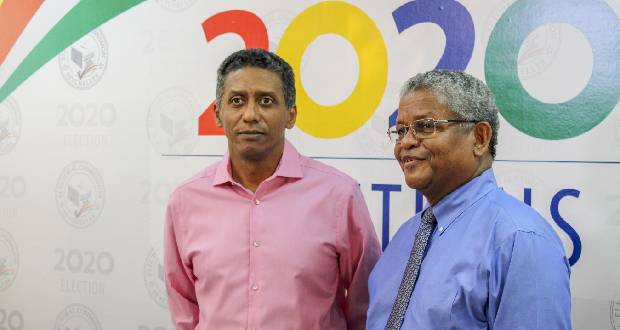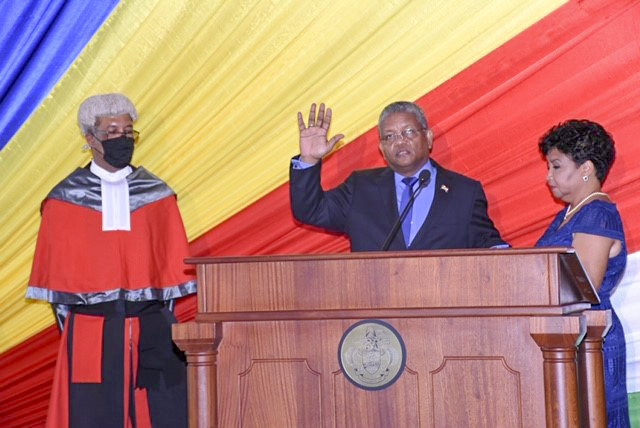Publicité
Seychelles: The new Ramkalawan era and Mauritius
Par
Partager cet article
Seychelles: The new Ramkalawan era and Mauritius

The election of Wavel Ramkalawan marks the beginning of a new era for the politics of Seychelles, bringing to an end the more than four-decade long rule of the party founded by Albert René and run by his political successors. So why did Ramkalawan win? And why should Mauritius, with a key strategic interest in Seychelles, pay attention to the way the new wind is blowing in Mahé.
Wavel Ramkalawan won Seychelles’ presidential election on Saturday, with his Linyon Demokratik Seselwa (LDS) not only winning the presidency but also 25 out of the 35 seats in Seychelles’ National Assembly marking the first time since the 1977 coup d’état that the grand old United Seychelles Party (USP) founded by Albert René, and currently headed by Danny Faure, has lost power. “This election marks many things”, Consultant and Seychelles-watcher Richard Ramasawmy tellsl’express,
“Despite changing its constitution in 1991 to introduce multi-party elections, this is the first real transfer of power from one party to another in over four decades, that too in a peaceful manner and with the opposition controlling not just the presidency but also two-thirds of Seychelles’ National Assembly that allows them to change the constitution.” Despite a build-up of frustration that led to the defeat of Faure and the USP, the results have come as a shock to observers of Seychellois politics.
During the last election in 2015, Ramkalawan faced off against USP’s James Alix Michel where Ramkalawan lost by a whisker, just 193 votes with voting going into a second round. Everybody, including Ramkalawan and Faure themselves, was expecting a close fight. “The fear here was that a third candidate (former tourism minister – ed.) Alain St. Ange would split off a few votes, further reducing the difference between Ramkalawan and Faure and force things into a second-round again”, explains Seychelles observer José Arunasalom, “that did not happen”.
Instead, St. Ange’s party got just 1.6 percent of the vote, Ramkalawan got 7404 more votes than Faure (a significant difference in a country with just over 71,000 registered voters) and Ramkalawan’s LDS ended up with a supermajority in the National Assembly with 25 seats as opposed to Faure’s USP, hitherto the most dominant force in Seychellois politics since 1977, left with just 10. “The magnitude of the USP’s defeat came as a shock to many”, Seychelles-based journalist Vidya Gappy tells l’express.
Who is Ramkalawan?
Politics in Seychelles has always been linked to Mauritius. Its first president James Mancham was close to Gaëtan Duval’s Parti Mauricien Social-Démocrate, the man who ousted Mancham in the 1977 coup, Albert René was linked to Paul Bérenger’s Mouvement Militant Mauricien. Ramkalawan’s story is no different: he was formed by religious institutions in Mauritius, graduating as an Anglican priest in 1985 from Mauritius’ St. Paul’s Theological College.
He exploded into the political scene in 1990 with a fiery radio sermon criticizing USP domination of the country as a oneparty state, secretly founding the LDS a year later. When the constitution was changed in 1991 to allow for other parties, Ramkalawan’s LDS was the first opposition party to officially be registered with Ramkalawan serving as leader of the opposition in Seychelles since 1998.
In that role, Ramkalawan shot to national consciousness with a number of stands that he took. When the Chinese government bankrolled the construction of a new National Assembly building for Seychelles, in December 2009, Ramkalawan led the opposition boycott the official inauguration, citing China’s lack of democracy. US diplomats quoted Ramkalawan as saying, “receiving a building which houses our democracy from a foreign government that doesn’t believe in a multi-party democracy and where the leaders are not freely elected is a slap in the face to the people of Seychelles”.

In May that year, after ten Seychellois hostages were taken by Somali pirates (including a member of the LDS), Ramkalawan found himself negotiating with one of the pirate leaders to secure their release.
More recently, several other factors ensuring Ramkalawan’s star continued to rise, while the hold of the USP continued to weaken. The first is a generational shift with Seychelles. “The USP has been in power for 43 years, but many things have changed during that time”, says Arunasalom.
One of those changes is that an entirely new generation of voters has come of age since the one-party system ended. “Voters in their 20s and 30s have grown up after 1991, they are not products of the old socialist, one-party system that dominated Seychelles between 1977 and 1991”, explains Ramasawmy. A lot of new voters as well as those disillusioned with the old USP shifted to Ramkalawan.
The second factor was the 2015 election that led to former USP leader James Michel winning the presidency, but Ramkalawan’s LDS winning a majority in the National Assembly. Unlike the Mauritian system, presidents are directly elected in Seychelles separate from those of the legislature.

Following the 2015 elections, in 2016, Michel stepped down and vice-president Danny Faure took over. With the LDS controlling the legislature, Faure had to deal with a lot of problems, according to Gappy,“he had a hard time getting ministers approved by the legislature dominated by Ramkalawan’s LDS that headed the Public Accounts Committee and challenged Faure all the time”. Nowhere was Faure’s problem better illustrated than in the Indian push to establish a military presence on Seychelles’ Assumption Island, 1 135 kilometers South-West of the capital, Victoria.
Back in 2015, India and Seychelles signed an agreement to set up a facility on Assumption. Ramkalawan, however, spearheaded opposition to giving Assumption to the Indians, even though Faure made the agreement public (something that has not yet happened in Mauritius concerning Agalega).
During a PIO parliamentary conference in January 2018, where Ramkalawan was invited as a chief guest, the opposition leader refused then-Indian foreign minister Sushma Swaraj’s request to revise his position, declaring, “Seychelles would never accept any naval base of any country, be it the U.S. or India or any other”. With no hope of getting the LDS-dominated National Assembly to ratify the agreement over Assumption, by June 2018 Faure simply abandoned the idea and the Indian military footprint in Seychelles stalled. “What happened with Assumption island too played its part and people remembered that it was Ramkalawan who headed resistance to that and forced Faure’s hand into abandoning it”, Gappy points out.
The third factor was the Truth, Reconciliation and National Unity Commission set up in 2018 to look into abuses committed against political opponents by the USP when it ran a one-party state between 1977 and 1993. Faure’s idea was a South African-style healing process that would be telecast live on television nationally in 2019.
“I believe this ended up hurting the USP,” says Ramasawmy, “seeing these testimonies of people talking about past political crimes against themselves and their relatives stirred up a lot of emotion”. For older voters, it brought back unpleasant memories and for the young, they were hearing all this for the first time and were shocked. That played against the USP and created a wave of sympathy for Ramkalawan and the opposition just a year ahead of an election.
Ramkalawan’s challenges
The new president of Seychelle’s faces several challenges. The first being that with the USP party monopolizing governance since 1977, the opposition parties in Seychelles have little experience in governing. “Ramkalawan will be the first president who has never actually held a post of any kind within the government”, Gappy posits. All previous presidents have come from the USP-party system created by Albert René: James Michel was René’s vice-president who took over after René retired in 2004 and ruled until 2016 when he too left office to his vice-president Danny Faure. “After USP domination for so long,” says Ramasawmy, “one of the biggest challenges for Ramkalawan will be to get his people inside the state bureaucracy to help him govern”.
Ramkalawan knows that he is inheriting a state apparatus crafted for USP rule, with his party having no experience in directly governing, which is why the triumphalism has been a bit muted. “He was very gentle with Faure, requesting his help to the new government and Faure responded positively,” says Arunasalom.
“The biggest file on Ramkalawan’s desk will be Covid-19 and tourism,” says Ramasawmy. Seychelles depends on the 400,000 tourists coming in each year for 70 percent of its foreign earnings. More dependent on tourism than Mauritius, Seychelles has been hit hard by Covid-19, with an estimated 10,000 mostly young people (in a population of less than 100,000) left without jobs.
The Mauritian angle
Few countries would be paying as much attention to what the Ramkalawan era brings as much as Mauritius. Historically, relations between Mauritius and Seychelles have not always been great. Following René’s coup in 1977, Mauritius criticized the undemocratic ouster of James Mancham, with Mauritian politicians including Duval and Sir Seewoosagur Ramgoolam urging outside intervention to bring Mancham back to power. In 1981, the Mauritian government openly accused Seychelles of meddling in its politics and helping the MMM. For its part, René criticized Mauritius for its economic and diplomatic ties to Apartheid South Africa. Bilateral relations between the Indian Ocean neighbors were not established until 1988.
In recent decades, ties between Mauritius and Seychelles have been steadily warming, with Mauritius having a growing strategic interest in the mood in Victoria. Specifically, a 2012 agreement between Mauritius and Seychelles to jointly manage a 396,000 square kilometer stretch of ocean between them and share whatever resources are found there.
Both Port-Louis and Victoria expect to strike oil in these waters and the protocol for sharing revenues between the two states is yet to be finalized. “Ramkalawan has already stated that he wants to consolidate the relationship between Seychelles and its neighbors”, Arunasalom points out, with so much time, effort and with so much to gain by cooperating, “I don’t expect to see Ramkalawan changing much in the equation between Seychelles and Mauritius”.
With Seychelles starting a new page in its history, time will tell what this would mean for Mauritius.
Publicité
Publicité
Les plus récents






